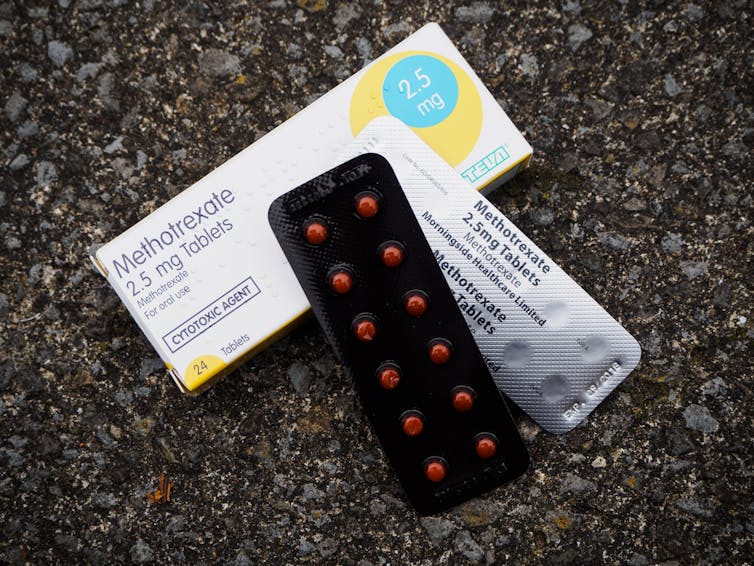Osteoarthritis is the most common disease of the joints, and often affects the hands. One in two women and one in four men will have symptoms of hand osteoarthritis by the time they turn 85.
Hand osteoarthritis causes pain and stiffness that can significantly impede a person’s ability to carry out activities of daily living such as dressing and eating, and to enjoy leisure activities.
Despite the significant effects hand osteoarthritis has on people’s lives, treatments are limited and often don’t work.
But relief could be on the way after our recent study found that an existing, affordable medication improves pain in patients with hand osteoarthritis.
Treatment is tricky
Finding treatments that work for hand osteoarthritis has been difficult because until recently we didn’t understand the causes of the condition. Many doctors are still taught that osteoarthritis is caused by “wear and tear” due to ageing and that inflammation is not an important factor in hand osteoarthritis.
However, research over recent years has shown this is not correct. Inflammation appears common in people with painful hand osteoarthritis and often leads to damage to joints.
Pharmaceutical companies have performed studies to see if their new medications that work very well in other inflammatory joint diseases such as rheumatoid arthritis will also work for patients with hand osteoarthritis.
But these medications, called biologic disease-modifying anti-rheumatic drugs, don’t work in hand osteoarthritis.
Read more: Arthritis isn't just a condition affecting older people, it likely starts much earlier
We wanted to understand why. These medications each target one single chemical in the body that causes inflammation, so we wondered if a medicine with a wider mechanism of action, which interrupts the processes causing inflammation in a number of different ways, might work in hand osteoarthritis.
This led us to consider whether methotrexate, a medication used for rheumatoid arthritis since the 1980s, might work for hand osteoarthritis. Methotrexate is an attractive option because doctors are familiar with how to use it, and it has been used in many patients over many years, so we know it’s safe.
It’s also relatively cheap (about $100 per year) so has the potential to be available to many patients compared with more expensive treatments that have been trialled. The biologic disease-modifying anti-rheumatic drugs, for example, can cost more than $10,000 per year.
In a survey we did before starting our study, we actually found that many rheumatologists were already prescribing methotrexate “off label” to treat patients with hand osteoarthritis because there was little else to offer them.

Now we have evidence methotrexate works
In our trial, we compared a standard dose of methotrexate (20mg taken orally once a week) to a placebo among patients with hand osteoarthritis and inflammation.
We selected people with hand osteoarthritis who had pain on most days in the last three months and moderate pain in the last seven days. We did hand X-rays to show they had osteoarthritis and not some other condition. We also did a magnetic resonance image (MRI) to make sure there was inflammation present.
We studied 97 people – 50 on methotrexate and 47 on the control medication – and followed them for six months.
As with most studies of osteoarthritis, we found that pain improved over the first month in both the control and methotrexate groups. This may be because people often enter a study when their pain is at its worst, so there is some improvement back to their baseline.
However, we found that the pain level did not improve any further in the control group but continued to improve in the methotrexate group. In the methotrexate group there was improvement at three months and even more so at six months. Across the full six months, the improvement in pain in the methotrexate group was twice as much as in the control group.
There are a number of limitations to our study. As it lasted six months, further work is needed to see if the pain continues to improve if people are treated for longer.
We also need to see whether methotrexate can reduce joint damage. This can be done by following people over one to two years and taking an X-ray to assess the condition of their joints after treatment.

What now?
Based on the results of our study, doctors may consider discussing the option of prescribing methotrexate with their patients who have significant symptoms of hand osteoarthritis.
The most common side effects of methotrexate are nausea and loss of appetite which are easily managed in most patients. Less common side effects include inflammation of the liver and a drop in the number of white blood cells. But a patient taking methotrexate will have regular blood tests to pick these problems up early if they occur.
A number of unanswered questions remain. We need to work out how long to use methotrexate for, whether it stops joint damage and which patients are most likely to benefit from methotrexate. We are especially keen to see if it helps women who can be highly affected by hand osteoarthritis that develops around menopause.

